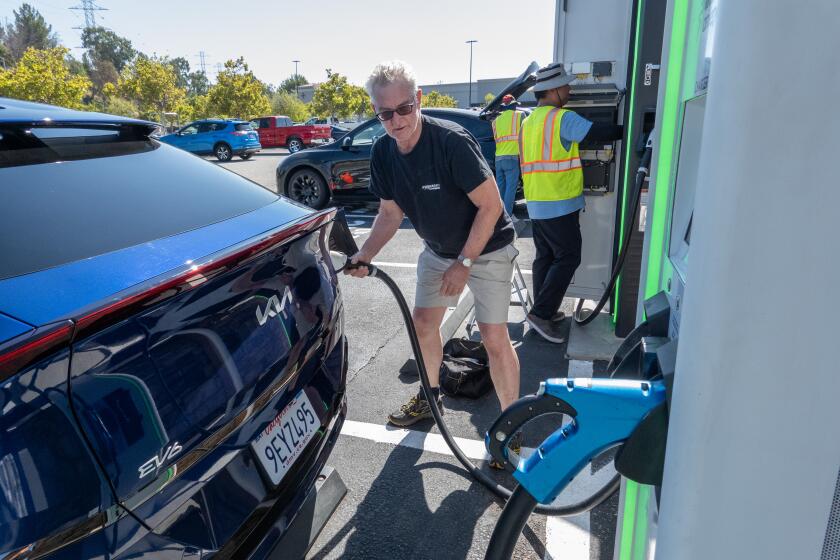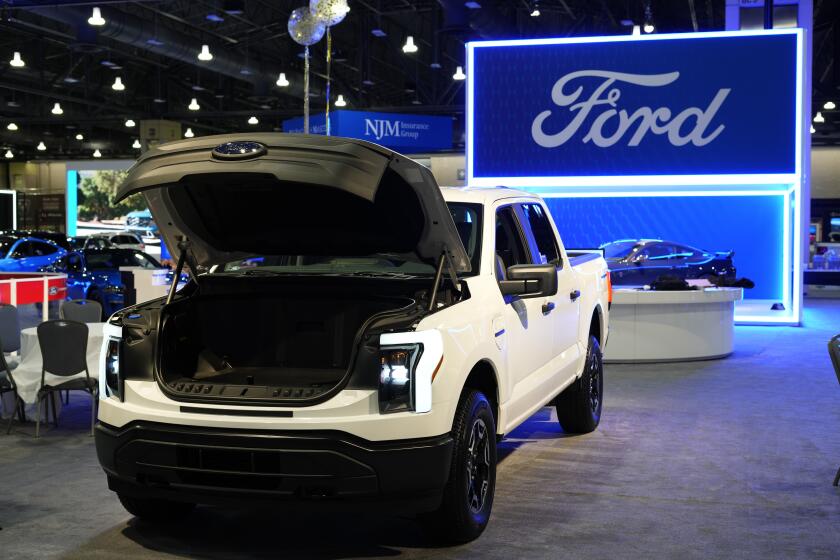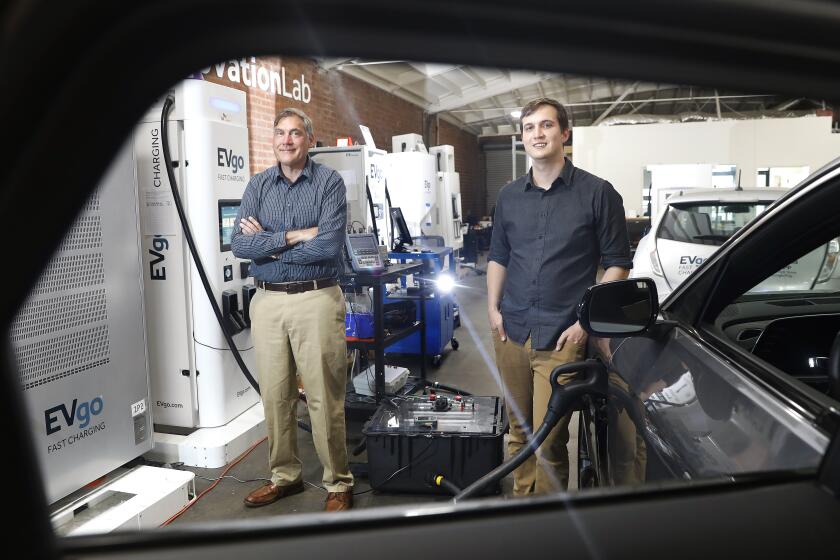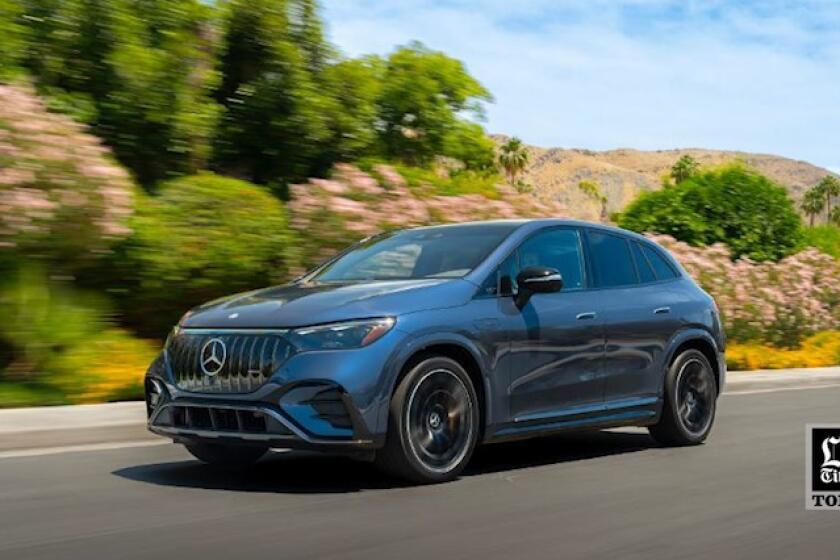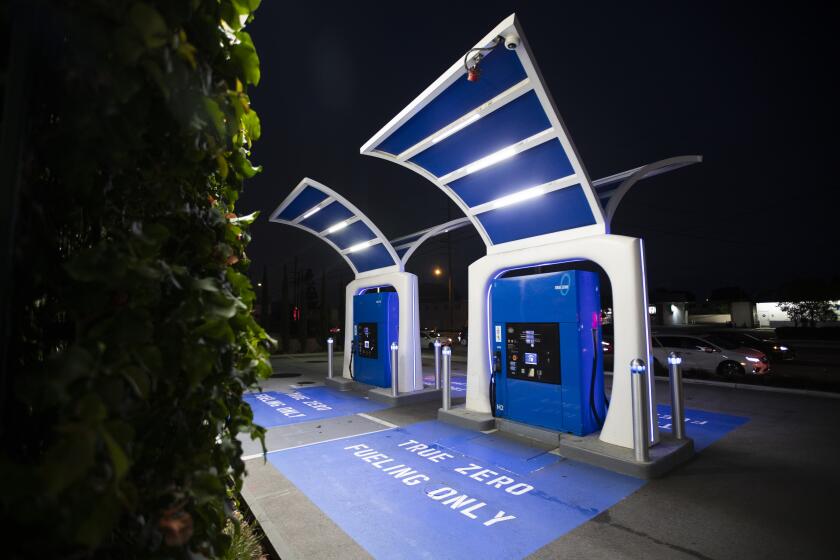California scales back EV rebates to focus on lower-income car buyers
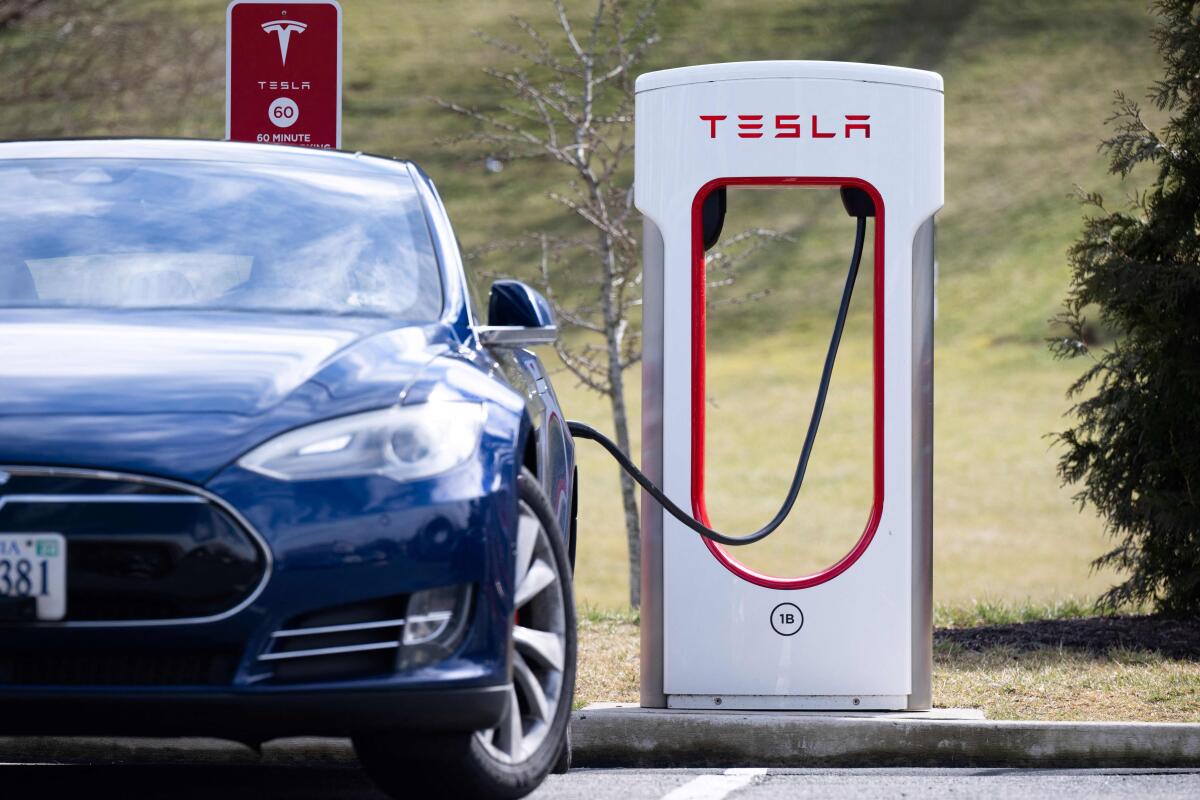
- Share via
California is eliminating its popular electric-car rebate program — which often runs out of money and has long waiting lists — to focus on providing subsidies only to lower-income car buyers.
The Clean Vehicle Rebate Project, in existence since 2010, will end when it runs out of money this year. In its place, the state will expand a program next year that provides subsidies only to low- to middle-income residents — those who have more trouble affording electric cars.
The income limits will be much more restrictive. Californians who earn more than 300% of the federal poverty level will no longer qualify for a state subsidy when they purchase an electric car, according to the California Air Resources Board. Currently, that level is $43,740 for an individual and $90,000 for a family of four, with sliding scales depending on household size.
In comparison, under the existing program that is being eliminated, individuals earning up to $135,000 and joint filers earning up to $200,000 qualified. The rebates for battery-powered cars varied from $7,500 for lower-income households to $2,000 for higher incomes.
Experts say the old program has been a key driver for helping Californians transition to electric cars. But now that the vehicles have become mainstream, the state will shift the emphasis to helping people who can’t afford their high price tags.
As autos writer for the L.A. Times, Russ Mitchell gets a lot of questions about electric car buying. Here’s his guide to choosing the right EV for you.
“The goal here is not to eliminate options for one group of motorists at the expense of another, but to assist those who’ve been unable to purchase a cleaner vehicle and to broaden and deepen the state’s ZEV [zero-emission vehicle] fleet. We need everyone possible to afford a ZEV, and this has been part of the plan to do that for a number of years,” air board spokesman David Clegern said.
The program, called Clean Cars 4 All, will be expanded statewide next year; it currently is available only in the five largest air districts. The revamped program will give people who meet the income requirements up to $12,000 to scrap and replace their older gas-powered cars with cleaner alternatives. Those not getting rid of an older car can qualify for up to $7,500 in purchase grants.
Car buyers also may qualify for a federal tax credit of up to $7,500 for some vehicles, with income restrictions of $150,000 for individuals and $300,000 for married couples filing jointly.
Bill Magavern, policy director of the Coalition for Clean Air, a Los Angeles-based advocacy group, said the state will “democratize clean transportation” with its more targeted subsidies.
“It is time for [the state rebate] to go away,” Magavern said. “When EVs were considered to be exotic and strange and out of reach for most people, it was important to have this broad-based rebate. But now EVs have gone mainstream.”
Only 10 electric and plug-in hybrid cars will qualify for the full tax credit in the U.S. out of 90 available EV options on the market.
But some car dealers worry that ending the rebate for middle- to higher-income Californians might discourage people from buying the cars.
Jessie Dosanjh, president of the California Automotive Retailing Group, a network of dealerships in the San Francisco Bay Area where about 20% of sales are electric vehicles, said the cars are still relatively expensive compared with other options.
Still, he said he understands why the state is shifting its focus to low- to middle-income consumers.
“As we’re moving into more mass adoption, I think it’s critical to have that income-based structure, because it opens up the market to some people who might be on the fringe, and not be able to afford it due to income limitations,” Dosanjh said.
The average price of an electric car was $53,469 in July, about 18% lower than a year earlier, according to Kelley Blue Book. The industry average for all 2023 cars in July was about $48,300.
As the market for electric vehicles expands, the reliability record for public EV chargers is poor, causing many would-be EV buyers to question whether it’s time to make the switch.
The Clean Vehicle Rebate Project has issued half a million rebates worth $1.2 billion. And the program remains wildly popular, hitting a record 14,000 applications in July, the air board said.
Now, its website announces: “Funds for CVRP are nearly exhausted. Applications received on or after September 6, 2023, will be placed on a standby list and are not guaranteed a rebate.”
“While it is disappointing to see the most successful incentive program in history end, the march toward eliminating traditional [rebates] and directing the very limited funding to equity programs has been clear for several years now,” said Steve Douglas, a vice president at the Alliance for Automotive Innovation, an auto industry group.
The goal: Making electric cars affordable for everyone
California is trying to electrify its 25 million cars, clean up its severe air pollution and reduce the state’s reliance on fossil fuels. To do so, the state is mandating that 35% of new 2026 car models sold in California must be zero-emission, climbing to 68% in 2030 and 100% in 2035.
For the mandate to succeed, the government has to ensure that people throughout the state, in all income levels, can afford electric cars.
But a CalMatters’ statewide analysis of ZIP Codes earlier this year showed extreme disparities in electric car ownership.
Communities with mostly white and Asian high-income residents have the state’s highest concentrations of zero-emission cars. In stark contrast, California ZIP Codes with the largest percentages of Latino and Black residents have extremely low proportions of electric cars — many with no electric cars at all.
Income seems to be the main driver of the disparities, according to CalMatters’ analysis. Most median household incomes in the top 10 ZIP Codes for electric cars exceeded $200,000, much higher than the statewide $84,097.
Dosanjh, from the Bay Area car dealership group, said early adopters were often higher-earning people who worked in the technology industry, or at least technology enthusiasts. But these days, he said he sees more people buying electric cars to replace their gas-powered vehicles, rather than having them as novelty and luxury items.
More than 1.6 million zero-emission vehicles have been sold in California; 1 in 4 cars sold during the second quarter of this year were zero emissions.
The future of clean car technology may very well be hydrogen fuel cells. While you can already drive one on the road today, filling it up conveniently is another matter.
Erich Muehlegger, a professor of economics at UC Davis, said the Clean Vehicle Rebate Project has been “the main workhorse to encourage people to buy zero-emissions vehicles.”
But the rebate program has been subject to inconsistent and inadequate funding, according to CalMatters reporting. Last year, the program was flooded with requests for the money, resulting in long waits.
In addition, the various state programs were confusing to Californians. Now they can apply in one place.
“Closing out the [rebate] program has been the plan for some time, and in 2015 the decision was made that when ZEVs reached 16% of new vehicle sales would be the point where that would happen. We let it run longer [25%] just to ensure we had a healthy market,” Clegern said.
“The state concluded that shifting financing to Californians who may have been left out of the ZEV market because of their income is the right thing to do and also deepens the market,” he said.
The program that will be expanded, Clean Cars 4 All, has assisted low- to middle-income households as well as families who live in areas designated as “disadvantaged communities,” with low socioeconomic status as well as environmental risks.
The new program will be rolled out with a revamped financing-assistance program for buyers.
The money comes from the state’s greenhouse gas reduction fund, which raises money by selling carbon allowances to pollution-emitting businesses, as well as money from the state’s budget.
This article was originally published by CalMatters. CalMatters.org is a nonprofit, nonpartisan media venture explaining California policies and politics.
More to Read
Inside the business of entertainment
The Wide Shot brings you news, analysis and insights on everything from streaming wars to production — and what it all means for the future.
You may occasionally receive promotional content from the Los Angeles Times.
